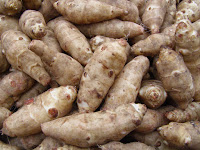 December 21, 2011 at 10:30pm was the moment that those of us residing within Mountain Standard Time experienced this winter's solstice, when the sun was at its southernmost point in the northern hemisphere's sky. It also marked the year's shortest day and longest night.
December 21, 2011 at 10:30pm was the moment that those of us residing within Mountain Standard Time experienced this winter's solstice, when the sun was at its southernmost point in the northern hemisphere's sky. It also marked the year's shortest day and longest night. Since that moment in time, our days have been getting progressively longer, something that is significant to those of us that miss the sunshine of summer. It is not just sun-starved humans that mark the lengthening days, however. Plants notice as well.
 For plants, light is necessary for life because it drives photosynthesis, the process by which plants' cells convert sunlight into food. For many plant species, day-length (or, more accurately, the length of uninterrupted darkness), is as much a trigger for the processes of seed germination, growth, flowering, fruit development, and the onset (or release from) winter dormancy as is the warmth of spring. Many plants will not grow at all, even in the presence of sufficient heat, when day lengths are shorter than 10 hours. For example, a southern gardener that writes for the periodical Growing for Market, observed that radishes sown during the winter in her greenhouse (which provided adequate warmth in that mild winter climate), were much slower to mature than radishes planted during the longer days of late spring or early fall. The radish variety she planted in early September took 29 days to come to fruition. Planted in November, the same variety took 77 days, and in late January, it took 65 days.
For plants, light is necessary for life because it drives photosynthesis, the process by which plants' cells convert sunlight into food. For many plant species, day-length (or, more accurately, the length of uninterrupted darkness), is as much a trigger for the processes of seed germination, growth, flowering, fruit development, and the onset (or release from) winter dormancy as is the warmth of spring. Many plants will not grow at all, even in the presence of sufficient heat, when day lengths are shorter than 10 hours. For example, a southern gardener that writes for the periodical Growing for Market, observed that radishes sown during the winter in her greenhouse (which provided adequate warmth in that mild winter climate), were much slower to mature than radishes planted during the longer days of late spring or early fall. The radish variety she planted in early September took 29 days to come to fruition. Planted in November, the same variety took 77 days, and in late January, it took 65 days. A plant that is triggered to flower when days are less than 12 hours long is described as “short-day.” Plants that form flowers and go to seed quickly when days stretch past 12 hours in length are “long-day.” If a plant is not responsive to day length, it is “day-neutral.” A number of commonly known garden plants are long-day. Consider, for example, the abundant leaves of lettuce and spinach during the shorter days of early spring, and their haste to flower and go to seed when summer days become long. Onions, too, are so notoriously sensitive to day length that most seed catalogs categorize varieties according to their short-, long-, or day neutral preferences.
As January draws to a close, and February approaches, our days' lengths are already gaining momentum. They will continue to do so until the summer solstice occurs on June 20, marking the longest day of 2012. And while it still might feel like winter has us in its grip, we can be encouraged because the ever-shortening nights are, even now, doing their greening work on the plant-life of our frozen landscape and our gardens.



















